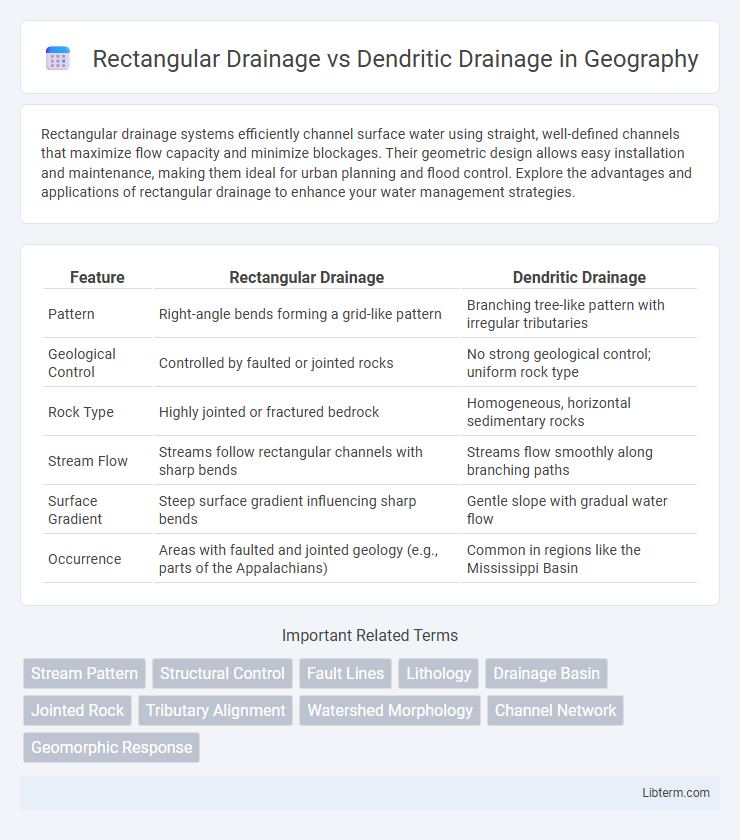Rectangular drainage systems efficiently channel surface water using straight, well-defined channels that maximize flow capacity and minimize blockages. Their geometric design allows easy installation and maintenance, making them ideal for urban planning and flood control. Explore the advantages and applications of rectangular drainage to enhance your water management strategies.
Table of Comparison
| Feature | Rectangular Drainage | Dendritic Drainage |
|---|---|---|
| Pattern | Right-angle bends forming a grid-like pattern | Branching tree-like pattern with irregular tributaries |
| Geological Control | Controlled by faulted or jointed rocks | No strong geological control; uniform rock type |
| Rock Type | Highly jointed or fractured bedrock | Homogeneous, horizontal sedimentary rocks |
| Stream Flow | Streams follow rectangular channels with sharp bends | Streams flow smoothly along branching paths |
| Surface Gradient | Steep surface gradient influencing sharp bends | Gentle slope with gradual water flow |
| Occurrence | Areas with faulted and jointed geology (e.g., parts of the Appalachians) | Common in regions like the Mississippi Basin |
Introduction to Drainage Patterns
Rectangular drainage patterns develop in regions with prominent faults or joint systems, where streams follow right-angle bends due to the underlying fractured rock. Dendritic drainage patterns resemble tree branches and occur in areas with homogeneous substrate, allowing water to flow freely without structural control. Understanding these patterns helps in interpreting geological structures and managing water resources effectively.
Defining Rectangular Drainage System
Rectangular drainage systems are characterized by channels that intersect at right angles, typically developing in regions with highly jointed bedrock or faulted landscapes. This pattern results from the terrain's structural control, where water flow is directed by two dominant sets of fractures or joints, creating a distinct grid-like network. Unlike dendritic drainage, which resembles tree branches with irregular, branching streams, rectangular drainage exhibits a more angular and geometric arrangement of watercourses.
Understanding Dendritic Drainage System
Dendritic drainage systems develop in regions where the underlying rock structure is uniform and lacks significant fractures, leading to a tree-like, branched pattern of streams that resembles the veins of a leaf. This type of drainage optimizes surface water flow by following the slope of the terrain without structural control, resulting in numerous tributaries joining larger rivers at acute angles. Understanding dendritic drainage enhances the prediction of water movement, soil erosion patterns, and watershed management compared to the rectangular drainage system, which is controlled by jointed or fractured rock formations creating right-angled stream intersections.
Key Differences Between Rectangular and Dendritic Drainage
Rectangular drainage features channels intersecting at right angles on a network of fractures or faults, creating a distinctive grid-like pattern, while dendritic drainage resembles the branching pattern of tree limbs, developing on homogeneous substrates without structural control. The key difference lies in their formation: rectangular drainage results from structural influences such as jointed or faulted rocks, whereas dendritic drainage forms over uniform lithology with minimal structural disruptions. This structural control in rectangular drainage leads to sharply angled stream junctions, contrasting with the smoothly branching, irregular junctions of dendritic drainage.
Geological Conditions Favoring Each Drainage Type
Rectangular drainage patterns develop primarily in regions with homogeneously fractured bedrock where joints or faults intersect at roughly right angles, promoting stream channels that follow these structural weaknesses. Dendritic drainage forms in areas with relatively uniform lithology and gentle slopes, where the substrate lacks significant structural control, allowing the river network to resemble the branching of tree limbs. The geological conditions for rectangular drainage emphasize fault-controlled terrains, while dendritic patterns dominate in flat-lying sedimentary rocks or unfractured igneous rocks with consistent resistance to erosion.
Formation Processes of Rectangular and Dendritic Drainages
Rectangular drainage forms through the systematic jointing and faulting of bedrock, resulting in streams that intersect at near-right angles due to the control of structural weaknesses. Dendritic drainage develops over homogeneous, unfractured rocks where the landscape lacks structural controls, allowing tributaries to branch in irregular, tree-like patterns following the slope of the terrain. The contrasting formation processes stem from the influence of geological structures in rectangular systems versus uniform lithology in dendritic systems.
Hydrological Implications of Both Drainage Patterns
Rectangular drainage systems exhibit pronounced right-angle bends and channel networks that enhance rapid surface runoff and efficient flood conveyance, often leading to concentrated discharge points. In contrast, dendritic drainage patterns, characterized by branching tree-like tributaries, promote more evenly distributed infiltration and sustained baseflow due to greater catchment area integration. Hydrologically, rectangular drainage tends to intensify flood peaks and shorten lag times, whereas dendritic drainage supports more stable streamflow and improved groundwater recharge.
Environmental Impact: Rectangular vs Dendritic Drainage
Rectangular drainage patterns, characterized by right-angle bends following jointed and fractured rock formations, often lead to enhanced surface runoff and reduced groundwater recharge, potentially increasing soil erosion and flood risks. Dendritic drainage systems, resembling branching tree limbs, promote more natural water distribution and infiltration, supporting soil stabilization and reducing erosion through efficient groundwater recharge. The environmental impact of rectangular drainage is often more pronounced due to disrupted water flow, while dendritic patterns typically maintain ecological balance and sustain watershed health.
Real-World Examples of Each Drainage Pattern
Rectangular drainage patterns develop where the underlying rock features prominent joints and faults, creating right-angle bends; notable examples include the Delaware River Basin in the United States and parts of the Western Ghats in India. Dendritic drainage patterns resemble tree-like branching and form in regions with uniform material and gentle slopes, commonly observed in the Mississippi River Basin and the Ganga River Basin. These drainage patterns significantly influence water flow, sediment transport, and landscape evolution in their respective regions.
Conclusion: Selecting the Right Drainage System
Selecting the right drainage system depends on the underlying geological structure and slope of the terrain. Rectangular drainage suits areas with faulted or jointed landscapes, maximizing water flow efficiency through its right-angled channels. Dendritic drainage best fits regions with uniform materials and gentle slopes, promoting natural, tree-like water distribution patterns.
Rectangular Drainage Infographic

 libterm.com
libterm.com